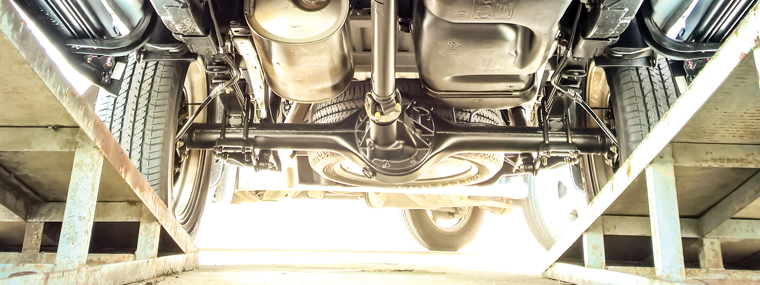
Selling Undercarriage Cleaners
By Diane M. Calabrese / Published April 2019

Call it a drag. Label it a hindrance. The combination of dirt and debris on moving objects—from baseballs to rockets—slows them down, or worse, causes erratic behavior.
A clean vehicle uses less fuel. It also runs more safely. According to TheTruckersReport.com, the legal weight for an eighteen-wheeler is 40 tons in the United States. Oversize permits can push the weight higher.
If it seems that it would take an enormous amount of dirt and debris to add up to notable drag on a semi-truck or cause it to move unpredictably, answer a question: How much comfort would a passenger have boarding a plane with a filthy exterior? (Ice coating the exterior? Forget it.)
Everyone has an intuitive understanding of the dangers drag poses. True, many people get their vehicles washed just for cosmetic reasons, but quite a number also understand the safety issues.
Moreover, understanding of the importance of cleaning the under-carriage of a vehicle is growing. Keith Barry addressed the issue in a Consumer Reports article (“Are Car-Wash Extras Worth It?”) in August 2018 (https://www.consumerreports.org/car-maintenance/should-you-pay-more-for-a-car-wash).
Add the U.S. number of cars to the number of trucks; the sum makes the potential market for undercarriage cleaning very large. Yet the market is larger still, as any motor-powered vehicle with an undercarriage needs to be cleaned, and that list includes mass-transit cars as well as the heavy equipment in construction, farming, logging, and more.
In short, sellers of undercarriage cleaners serve a large and growing market. It’s also a diverse market with different sorts of cleaners serving different kinds of customers.
Undercarriage cleaners range from hand-held devices to in-line systems. (In the accessories guide article on page 6 in this issue, a contributor describes an accessory that can be used as an undercarriage cleaner as part of its three-in-one capabilities.)
Manufacturers and distributors of undercarriage cleaners work to put the correct cleaner into each setting. Before making recommendations, they work with end users to under-stand the type of undercarriage, the frequency of cleaning, and the cleaning goals.
Road safety is just one factor in the mix. “Cleaning the undercarriage not only allows prolonged life and improved appearance of a vehicle, but also adds a large safety benefit for not only the vehicle but also the technician servicing or inspecting it,” explains Jaimie Sokolski, sales manager at Mosmatic Corp. in Bristol, WI.
“Falling debris can fall into the eyes, ears, nose, or mouth when you are wrenching or inspecting,” says Sokolski. “Washing off the mud, salt, and corrosion will also help you find any fluid leaks and their sources, as the debris under a chassis can mask or hide these potential hazards if you are not doing a thorough inspection.”
Sellers of undercarriage cleaners understand the significance of being able to get to places that are hard to reach and see. “Maneuverability,” says Sokolski, is a critical component of the cleaner.
Among the many varied settings in which undercarriage cleaners from Sokolski’s company have been adopted, there are some particularly interesting ones. “Our Hurricanes have been used at marinas with hot water to clean off the boat hulls and help prevent the transfer of invasive aquatic species like zebra mussels,” he says.
And yet there are some settings that do not seem to be making as much use of undercarriage cleaners as they might. One of them is the commercial lawn industry, says Sokolski.
Sellers of undercarriage cleaners aim to ensure buyers purchase the equipment that works best for them. Cleaning impact must be assessed, for example, says Sokolski. If the height of impact is too short, which it might be with a low fan-style cleaner, the actual impact on a chassis such as a school bus will not be great enough to clean effectively.
Flexibility
The frequency with which an end user requires an undercarriage cleaner is one consideration when making a purchase. Many less-frequent users want a combination tool.
“Our company has an undercarriage cleaner that was developed to apply chemical with a power washer, but it will still do undercarriage cleaning,” says Brian Elkins, sales professional at Steel Eagle in Elk Point, SD.
 Elkins works with customers to make certain they understand the requirements for optimal performance of whichever kind of undercarriage cleaner they choose. When a pressure washer is being used with a spinner, for instance, the capability of the pressure washer must be factored in the choice.
Elkins works with customers to make certain they understand the requirements for optimal performance of whichever kind of undercarriage cleaner they choose. When a pressure washer is being used with a spinner, for instance, the capability of the pressure washer must be factored in the choice.
“Our undercarriage spinner has a four-arm spray bar on which we use four spray nozzles,” says Elkins. “Smaller power washers struggle with the four nozzles. When looking to buy an undercarriage spinner, your power washer needs to have enough flow to run four nozzles. I like four gpm or more.”
The more carefully a seller can assess how the undercarriage cleaner will be used, the better the recommendations that can be made. “With our longer handle option, the undercarriage cleaner can be slid under a vehicle while the operator stands back away from the hot water overspray,” says Elkins. “This handle also gives the operator access to areas not normally washed in a standard wash bay.”
Safety is bolstered with a longer handle, says Elkins. “This longer handle helps to keep the operator safer and hopefully drier but still does a thorough cleaning job.”
Adjustable handles add to flexibility, too. “Our company’s longer and adjustable handle is very beneficial,” says Elkins. “Shorten it up for cleaning a small vehicle or lengthen it out for a large truck.”
Elkins would like to see more commitment to keeping the “underbody” of vehicles clean. Cities, counties, and states could do more to maintain and increase the longevity of their fleets with such cleaning.
“In the upper parts of the country, salt, salt brine, and dust control are used on roads,” says Elkins. “Salt and salt brine help with ice and snow removal, but they are very corrosive to the undercarriages of vehicles during the winter months. Dust control is equally corrosive in the summer months.”
By cleaning undercarriages and stopping corrosion, fleet owners could add years to longevity of vehicles, says Elkins. “This cleaning also helps with DOT inspections and saves costly repairs to the fleet.”
Enormity of the Market
Sellers of undercarriage cleaners have a very large potential market. An August 20, 2018, press release from the American Trucking Associations put the annual revenue of the trucking industry at $700.1 billion in 2017. In the same year, there were 3.5 million drivers and 7.7 million individuals employed in the trucking industry.
The Federal Highway Administration (FHWA) reported 268,799,083 registered motor vehicles (of all kinds) for 2016 (2017 not available at this writing). Average annual fuel consumption per vehicle was 658 gallons. The average mileage per gallon overall was 17.9, while the average for light-duty vehicles (includes passenger cars) was 24 mpg.
One study assessed how much dirt and debris increased fuel consumption in passenger cars. It concluded the contaminants bumped average consumption up from 24 mpg to 26 mpg.
As the cost of gasoline increases and a possible carbon tax looms, anything that maximizes mileage, including undercarriage cleaning, becomes a selling point to consumers. And it’s a point that sellers of undercarriage cleaners can use when talking with their prospective customers.
Focus on environmentally friendly outcomes propels interest in undercarriage cleaners in some surprising sectors. For example, the U.S. Department of Agriculture has strict guidelines for cleaning off-road vehicles that might spread weeds or invasive species. Thus, the federal government becomes a potential buyer of undercarriage cleaners.
As big as the market for undercarriage cleaners is, it’s not a standalone opportunity. For one, users of undercarriage cleaners must meet requirements for wastewater collection and disposal or recycling.
We would be remiss not to mention the contrarian view that some contaminants on vehicles are not bad. It’s a view sometimes supported by the aerodynamic nature of a golf ball with all its protrusions. The difference is in the dispersion of the additions. Contaminants on or under the body of a vehicle are not equally dispersed, and they contribute to drag.
Race car drivers have been using shields on the front of their vehicles—in front of the axle—for years to streamline the vehicles to the fullest extent. Truckers and other vehicle owners are now doing the same. On big vehicles, gains of more than one-half mile per gallon have been documented.
Extracting a maximum mileage per gallon of fuel is environmentally friendly. So is ensuring longevity of a vehicle.
Cleaning the undercarriage protects a vehicle from the accumulation of material that would cause overheating. It removes salt that could start oxidizing the metal, leading to dreaded corrosion and rust. Attention to the undercarriage of vehicles should also cut the costs of maintaining the vehicle because components will not fail due to rusting or clogging.
The longer the lifespan of motor-powered vehicles, the fewer emissions (e.g., in steel production, mining, recycling) will be released in the making of replacements. Sellers of undercarriage cleaners are actually selling tools that help to reduce the carbon footprint of vehicles in multiple ways. It is one excellent selling point.





